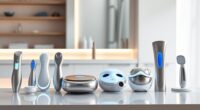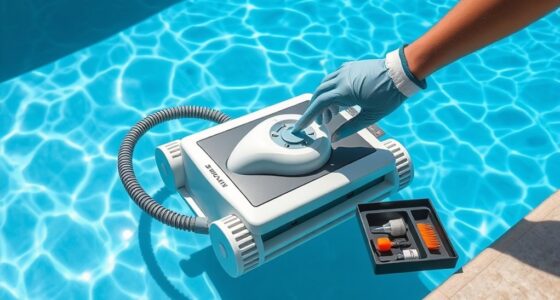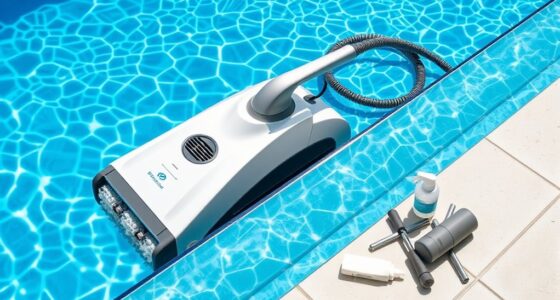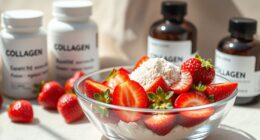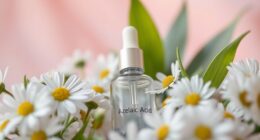Professional cleaners avoid using toxic products like chemical disinfecting wipes, harsh oven and drain cleaners, and ammonia-based glass cleaners in their own homes because they understand the health risks involved. They steer clear of disposable dusters, glossy floor products with VOCs, and chemical mixtures like bleach combined with vinegar or ammonia, which produce dangerous fumes. Instead, they choose safer, natural options. If you want to learn more about how to keep your home healthier, keep exploring these safer alternatives.
Key Takeaways
- Professionals avoid chemical disinfectants like quaternary ammonium wipes and harsh oven or drain cleaners due to health and environmental risks.
- They do not use ammonia-based window cleaners or mix bleach with vinegar, preventing toxic gas production.
- They steer clear of disposable dusters and glossy floor cleaners that contain synthetic fibers, waxes, or VOCs harmful to indoor air quality.
- They avoid stainless steel cleaners that leave residues or require harsh chemicals, favoring gentle, natural alternatives.
- They do not handle hazardous industrial-grade chemicals without proper safety measures, opting for safer, enzymatic, or natural cleaning solutions instead.
Disinfecting Wipes

Disinfecting wipes are a popular cleaning choice, but many contain questionable chemicals like quaternary ammonium compounds that can irritate your skin and cause respiratory problems. These harmful chemicals are often hidden in the ingredients, making it easy to unknowingly expose yourself to potential health risks. Proper use of disinfecting wipes requires keeping surfaces wet for several minutes to ensure effective sanitization, but many people don’t follow this step, reducing their effectiveness and increasing chemical buildup. Reusable disinfecting wipes offer a safer, eco-friendly alternative, helping you reduce waste and limit chemical exposure. However, even so-called “eco-friendly” wipes can contain harmful preservatives or fragrances that compromise indoor air quality. Always check labels and use disinfecting wipes carefully to avoid unnecessary chemical risks. Additionally, being aware of affiliate disclosures can help consumers make informed choices about the products they purchase and use. Research shows that frequent use of chemical-laden disinfectants may contribute to indoor air pollution, which can negatively affect respiratory health over time. Recognizing chemical exposure sources in household cleaning can help you make safer choices. For example, choosing products that are free from harmful preservatives can significantly improve indoor air quality. Furthermore, advancements in AI in Education are leading to smarter cleaning solutions that can help monitor and improve indoor air quality in real-time.
Disposable Dusters

Disposable dusters generate unnecessary waste and cost more over time compared to microfiber cloths. They often fail to remove dust effectively, instead just pushing particles around or trapping them temporarily. Switching to reusable microfiber cloths is a smarter, greener choice that cleans better and saves money. Additionally, microfiber cloths are more environmentally friendly, reducing landfill waste and pollution associated with disposable products. Using microfiber cloths also minimizes exposure to harsh chemicals, which are often found in traditional cleaning products and can cause skin and respiratory irritation. Furthermore, embracing mind-body awareness during cleaning routines can help individuals become more conscious of the products they use and their environmental impact. Recognizing the importance of sustainable cleaning practices can lead to healthier homes and a healthier planet.
Subheading 1: Wasteful and Costly
Many disposable dusters are made with synthetic fibers that only pick up surface dust, making them less effective than microfiber cloths. They often have chemical coatings or sprays that release VOCs and irritants during use, posing health risks. These dusters generate significant waste, contributing to environmental pollution and landfill buildup. Over time, buying disposable dusters adds up, costing you more than reusable options. Professional cleaners prefer microfiber cloths because they’re durable, effective, and eco-friendly. Consider this:
Environmental impact of disposable dusters is considerable due to their single-use nature and chemical components.
| Feature | Disposable Dusters | Microfiber Cloths |
|---|---|---|
| Effectiveness | Less surface dust pickup | Better at trapping dust |
| Waste | High, single-use | Low, washable |
| Chemical Coatings | Common, VOC release | Rare or none |
Switching saves money and reduces waste.
Subheading 2: Ineffective Dust Removal
While disposable dusters may seem convenient, they often fall short when it comes to thoroughly removing dust from surfaces. They trap dust temporarily but fail to eliminate it completely, leaving residual buildup. Unlike microfiber cloths, which are designed to capture fine particles effectively, disposable dusters made of synthetic materials struggle to do the same. Additionally, they often lack the proper connectors needed to attach to various cleaning tools, further limiting their effectiveness. Moreover, disposable dusters are typically made from synthetic materials, which do not have the same dust-absorbing properties as natural fibers. Consider this: 1. You might think you’re cleaning, but dust remains hidden, settling back quickly. 2. You’re wasting money on single-use products that don’t serve their purpose. 3. You’re contributing to unnecessary waste with each replacement. Professional cleaners prefer microfiber cloths because they’re durable, reusable, and far more effective at removing dust thoroughly. Disposable dusters simply don’t measure up.
Glossy Floor Cleaners

Glossy floor cleaners often contain waxes or synthetic polymers designed to create a shiny surface, but these ingredients can cause more harm than good. Many of these household chemicals trap dirt and grime beneath the surface, leading to dullness over time. They also build up and require stripping, which can damage your floor’s finish. Excessive use of these products can make floors slippery, increasing the risk of falls. Plus, the synthetic polymers can be tough to remove and may leave sticky residues behind. These chemicals can also impact indoor air quality, releasing volatile organic compounds (VOCs) that may cause respiratory issues. For safer, natural shine, regular cleaning and simple solutions are often all you need, avoiding the potential hazards of toxic glossy floor cleaners. Using safer cleaning methods can help maintain your floors’ appearance without compromising health, especially when considering indoor air quality and long-term floor integrity. Incorporating eco-friendly cleaning products can further reduce exposure to harmful chemicals and support a healthier home environment. Being aware of chemical ingredients in cleaning products is key to making healthier choices for your home—and staying informed about green cleaning practices can lead to safer, more sustainable routines.
Stainless Steel “Cleaners
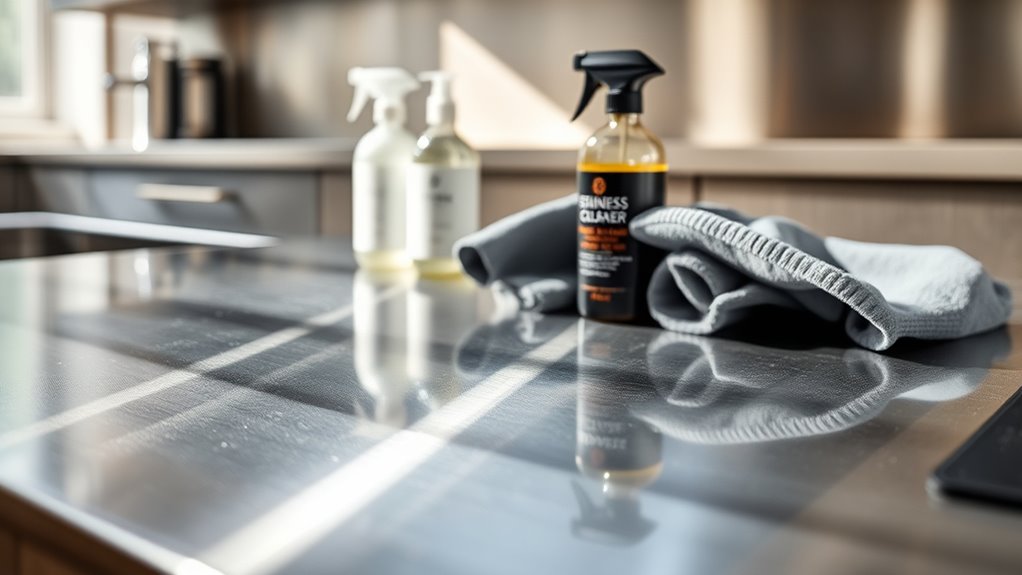
Stainless steel “cleaners” are often marketed as quick fixes to achieve a shiny, polished look, but they can do more harm than good if misused. Many of these household products focus on adding shine rather than cleaning, leaving behind residue or streaks. Overuse can cause a buildup of wax or oil layers that trap dirt, making your stainless steel look dull over time. To avoid this, you should:
- Rely on simple soap and water for initial cleaning, not harsh household products.
- Use only a small amount of stainless steel cleaner, spreading it evenly.
- Recognize that polishing is secondary, after removing grime and food residue.
- Professional cleaners skip these stainless steel “cleaners,” opting for gentle cleaning methods to preserve the natural shine without damaging your surfaces.
- Understanding surface dynamics helps maintain the integrity and appearance of your stainless steel over the long term. Additionally, awareness of product misuse can prevent long-term damage caused by improper cleaning techniques.
- Being mindful of surface protection methods ensures that your stainless steel surfaces stay pristine without unnecessary wear.
Ammonia-Based Window and Glass Cleaners
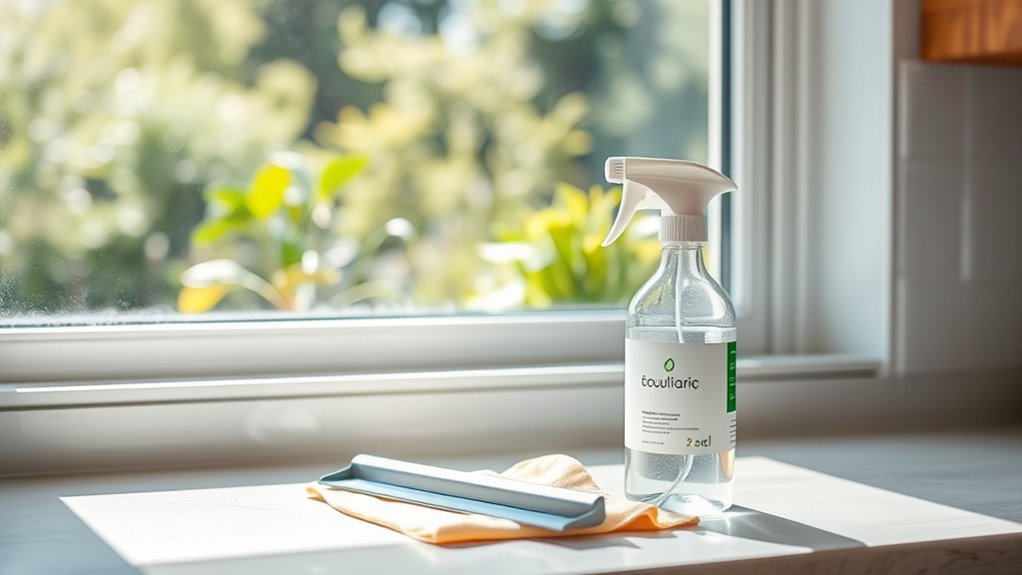
Have you ever considered the risks lurking behind those traditional ammonia-based window and glass cleaners? These household cleaners contain ammonia, a toxic chemical that can cause respiratory irritation, eye damage, and skin burns if you’re not careful. When mixed with bleach or other household chemicals, ammonia releases hazardous fumes like chloramine vapors, which can lead to severe breathing problems or poisoning. Using ammonia cleaners without proper ventilation increases indoor air pollution and puts children, pets, and people with respiratory issues at risk. Since ammonia in these household cleaners is often industrial-grade and classified as hazardous by OSHA, handling and storing them safely is essential. Safer alternatives, such as vinegar-based or natural plant-based glass cleaners, can give you a streak-free shine without the health dangers.
Hazardous Chemical Combinations (e.g., Bleach and Vinegar)
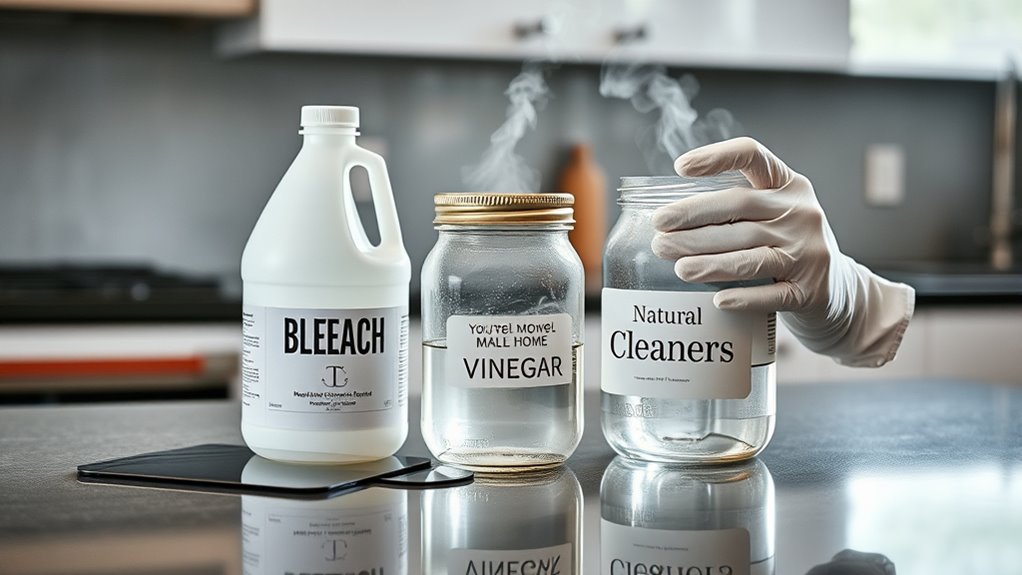
Mixing bleach and vinegar creates dangerous chemical reactions that release toxic chlorine gas. Inhaling these fumes can cause severe respiratory problems and eye irritation. Always keep these substances separate to protect yourself from serious health risks.
Dangerous Chemical Reactions
When bleach and vinegar are combined, they react quickly to produce dangerous gases that can harm your health. These chemical reactions release chlorine gas, which can cause severe respiratory irritation, coughing, and even lung damage. The toxicity of these reactions isn’t limited to immediate effects—long-term health risks like chronic respiratory issues can develop.
Consider these dangers:
- Breathing in toxic chlorinated compounds can cause acute poisoning.
- Skin contact with reactive chemicals leads to burns or irritation.
- The rapid, exothermic reaction increases the risk of accidental exposure in enclosed spaces.
Professionals avoid mixing household cleaners because of these unpredictable chemical reactions. Always remember, combining cleaning products can produce hazardous gases that threaten your safety and health.
Toxic Gas Production
Combining household cleaning products like bleach and vinegar can lead to the release of hazardous gases that pose serious health risks. When mixed, they produce toxic chemicals such as chloramine and dichloramine gases, which irritate your eyes, throat, and lungs. Inhalation of these fumes can cause respiratory issues like chest pain and even pulmonary edema. It’s essential to understand that even small amounts can be dangerous without proper ventilation. To help you recognize the risks, here’s a quick comparison:
| Chemical Reaction | Potential Health Impact |
|---|---|
| Bleach + Vinegar | Toxic fumes, respiratory issues |
| Chloramine gases | Chest pain, lung irritation |
| Hazardous gases | Severe respiratory problems |
| Proper use | Prevents dangerous gas production |
Health Risks Amplified
Because bleach reacts with acidic substances like vinegar, it releases highly toxic chlorine gas that can quickly harm your health. This dangerous chemical reaction produces fumes that irritate your eyes, throat, and lungs, risking serious respiratory problems. When you mix these cleaners, you risk:
- Triggering coughing fits and chest pain that can escalate quickly.
- Causing chemical burns or poisoning from inhaled fumes.
- Increasing indoor air pollution, which can lead to long-term lung damage.
These hazardous chemical reactions make it unsafe to combine bleach with vinegar. Inhalation of the fumes can lead to severe respiratory issues, including chemical pneumonitis and systemic toxicity. Protect yourself by avoiding these dangerous combinations altogether.
Harsh Oven and Drain Cleaners

Harsh oven and drain cleaners often contain powerful chemicals like sodium hydroxide, potassium hydroxide, or strong acids that can cause serious skin burns, eye damage, and respiratory irritation if mishandled. These harsh chemicals pose significant toxicity risks, especially when used improperly or mixed with other household cleaners like bleach or ammonia. Many professionals avoid these cleaners due to their corrosive nature, which can damage pipes and surfaces. In homes, accidental poisoning is a real danger, particularly for children and pets. Instead, safer options like baking soda, vinegar, or enzymatic drain cleaners are recommended. These alternatives effectively clear clogs and grime without exposing your household to the hazards associated with toxic, corrosive chemicals.
Frequently Asked Questions
What Is the Least Toxic Home Cleaner?
The least toxic home cleaner is usually a simple mix of water and vinegar, which kills germs and cleans surfaces safely. You can also use baking soda and lemon juice for deodorizing and scrubbing. DIY solutions with castile soap and essential oils work well too. Opt for certified eco-friendly products, and remember, regular soap and water are often the safest and most effective cleaning methods you can use daily.
What Two Household Chemical Cleaners Must You Never Mix?
Did you know that mixing household cleaners causes over 10,000 injuries annually? You must never mix bleach with ammonia-based cleaners, as it releases toxic chloramine gases that can harm your respiratory system. Also, avoid combining bleach with vinegar, which produces dangerous chlorine gas. Always read labels and use products separately to stay safe and prevent harmful chemical reactions in your home.
What Cleaning Products Have High VOCS?
You should avoid cleaning products with high VOC levels like aerosol sprays, air fresheners, and chlorine bleach. These products release volatile organic compounds such as formaldehyde, benzene, and toluene, which can pollute your indoor air and pose health risks. Look for low-VOC or VOC-free labels, especially if your home isn’t well-ventilated. Choosing safer options helps protect your family’s health and reduces indoor pollution.
What Cleaning Products Are Safe for the Lungs?
Think of your lungs as delicate gardens needing gentle care. To protect them, choose cleaning products with natural ingredients like vinegar and baking soda, or EPA-registered disinfectants with low VOCs. Avoid aerosol sprays and harsh chemicals like ammonia or bleach. Keep your space well-ventilated and opt for plant-based, non-toxic cleaners. By doing so, you guarantee your respiratory garden stays healthy and vibrant for years to come.
Conclusion
So, next time you reach for that shiny bottle or wipe, remember the secrets pros keep close. They steer clear of these toxic toxins, like a lighthouse avoiding rocky shores. Your home should be a safe harbor, not a chemical battleground. Choose natural, non-toxic options instead — your health and the environment will thank you. Keep your sanctuary sparkling without letting harmful chemicals sneak in like uninvited guests.

